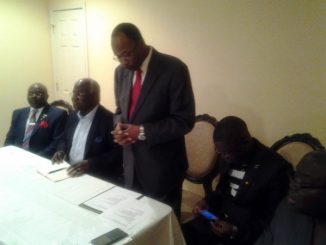
All travellers entering the United States from the Ebola-stricken nations at the heart of the current outbreak in west Africa will be monitored for 21 days under new rules which come into force on Monday.
The Centers for Disease Control (CDC) announced the radical measure last week, in a bid to prevent the nightmare scenario of a victim unknowingly passing the disease on while walking the streets of a US city.
Such an occurrence is known as the “Typhoid Mary” effect, after Mary Mallon, an asymptomatic typhoid sufferer originally from Ireland, who is thought to have passed the disease on to 53 people while working as a cook in New York at the turn of the last century.
She was forcibly placed in quarantine on two occasions and died 1938 having spent three decades in isolation.
Close calls involving Thomas Eric Duncan, the Liberian man who infected two nurses at Dallas Presbyterian Hospital before succumbing to the disease this month, and Dr Craig Spencer, who mixed with the public in New York for five days before developing a fever and reporting to hospital, have led CDC to tighten up the restrictions on those travelling to the US from west Africa.
But what do the new rules entail, who will they affect, and how effective are they likely to be?
Around 150 people a day fly to the United States from Sierra Leone, Guinea and Liberia.
While there are no direct flights from the west African nations at the heart of the outbreak, there are a number of routes into the US via European airports. The CDC had already announced that all those arriving from Sierra Leone, Guinea and Liberia would be required to enter via one of five airports which have introduced enhanced screening procedures, including checks for fever, one of the early signs of Ebola. They are New York’s JFK, Newark Liberty, in New Jersey, Dulles serving Washington DC, O’Hare in Chicago, and Hartsfield-Jackson in Atlanta. The trade group Airlines for America (A4A) says only about nine passengers a day, or six per cent of the total, enter the US via other airports, and airlines have been cooperating in re-routing them to the approved centres.
All those who have travelled from Ebola countries will face 21 days of monitoring
Once they are identified at one of the the five approved airports as having travelled from one of the Ebola-affected countries, travellers will be checked for symptoms. Anyone with a temperature or other sign that they may have the virus will be sent straight into isolation. Those who are asymptomatic will be required to undergo 21 days of “active post-arrival monitoring,” responsibility for which will be taken on by state and local health departments. The three-week self-monitoring period reflects the longest length of time for which a patient has developed symptoms after coming into contact with an affected victim.
The monitoring process:
The CDC will inform states if a traveller from an Ebola-affected nation is due to arrive in their area. If asked, they will provide technical support, funding and advice. Health department officials will be expected to maintain contact with the traveller for 21 days, receiving daily temperature reports and inquiring about the presence or absence of other symptoms associated with Ebola, including a headache, joint and muscle aches, weakness, diarrhea, vomiting, stomach pain, lack of appetite, or abnormal bleeding. As they arrive at the five airports, travellers will be given a “CARE” kit – standing for Check and Report Ebola – including a logbook to keep track of their symptoms, thermometer, a symptom guide and information about who to inform if they have symptoms.
Those who fail to comply will be tracked down
The CDC says immediate steps will be taken to track down a traveller who fails to check in with the local health department on a daily basis. However, officials in New York have already admitted they do not know what they will do if confronted with someone who refuses to comply with the new rules.
Anyone who develops symptoms will be sent straight to quarantine:;
Any traveller who develops symptoms of Ebola during the 21-day isolation period will immediately be isolated and evacuated by a Hazmat team to a hospital in their area which has been designated as an Ebola treatment centre.
Medical workers will be subject to enhanced monitoring in some states
New Jersey, New York, Illinois and Florida announced over the weekend that all health workers who had cared for Ebola patients would be put into mandatory quarantine in hospital. This followed the case of Dr Craig Spencer, who mingled with the public in New York for five days before developing symptoms and ultimately testing positive for Ebola. New York has now revised its rules amid an outcry over the treatment of Kaci Hickox, a nurse who returned from Sierra Leone on Friday via Newark, who complained that she had been treated like a “criminal.” New York now requires medical staff only to remain inside their homes for 21 days and to receive twice-daily visits from local health officials.
Opinion remains divided over whether the new regulations will be sufficient to prevent the spread of Ebola
The CDC is confident that the new rules will be sufficient to protect America from a mass Ebola outbreak. Critics will point out however that the agency also reassured the country that its protocols were rigorousness enough to protect medical staff in Dallas who treated the first patient. to arrive on American soil. Two nurses were infected. and dozens put at risk through direct and indirect contact. Many Republicans continue to call for a ban on all travel from Ebola -affected nations, a stance which Anthony Fauci, head of the National Institute of Allergy and Infectious Diseases, has described as counter-productive, as it would be likely to put health care workers off volunteering to help in the Ebola zone.
THE TELEGRAPH





Leave a Reply